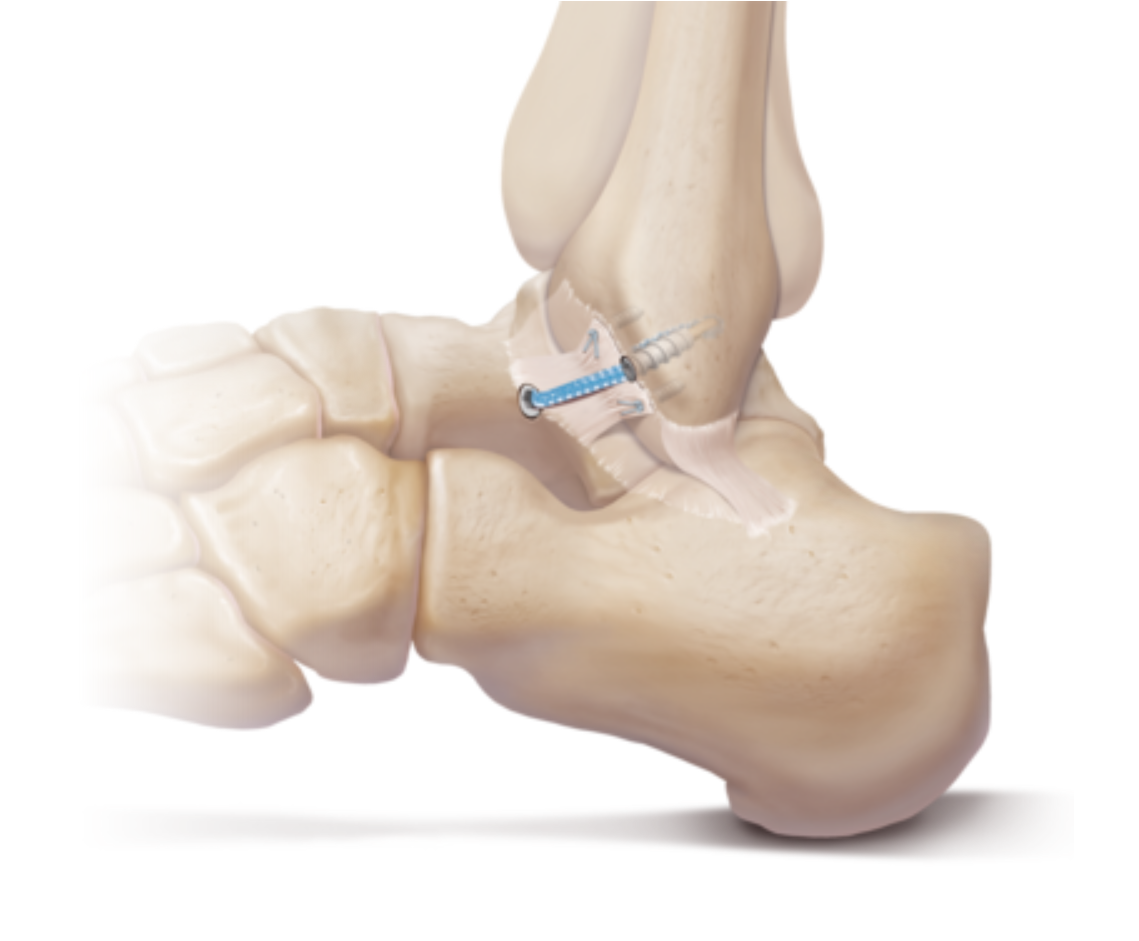Ankle Bostrum Ligament Repair
Procedure
Brostrum ligament repair with internal brace.
Aims of surgery
To reduce pain and instability of the ankle joint. Prevent long-term arthritis to the ankle joint.
Advantages of this operation
Restores and supports the natural ligament.
Reduces risk of the repaired ligament stretching out or re-rupturing.
Faster return to activity.
Specific risks of this operation
Nerve/Tendon/Blood vessel damage.
Deep Vein Thrombosis/Pulmonary Embolism. Problems with ligament anchors.
Further surgery.
Operation time
Usually between 45–60 minutes.
Incision placement/stitches
A cut is made over the outer side of the ankle.
Procedure
The remains of the ligament are found. Small grooves are made in the bone on the outer side of the ankle (the “lateral malleolus”). Small anchors are placed in the bone and stitches attached to these anchors are used to fasten the ligaments back in place. A ligament augmentation rope (internal brace) is then placed over the top of the repaired ligament. The tissues on the outer side of the ankle are then stitched to the ligament to support it. The skin is closed, usually with a dissolving stitch buried under the skin.
Fixation
Internal fixation (bone anchors) are used to repair the ligament. You will not notice these and do not need to be removed.
Will I have plaster?
No. You will be provided with a special boot, which needs to be worn for a minimum of 4 weeks.
Is this a Day Procedure?
Yes, you can usually go home the same day (you will usually be admitted for half a day).
Estimated time off work
Non-manual work approximately 4 weeks.
Manual work 4–6 weeks.
Indications for the procedure
Chronic ankle inversion sprains and pain.
Alternative treatments
Physiotherapy to settle down in ammation in your ankle. Strengthen the muscles on the outside of your ankle (peroneal muscles) to help control the joint. Wobble-board exercises to re-teach the nerve endings inside the ankle to work better.
If the physiotherapy does not improve your ankle, we would then arrange investigations to con rm that your ankle is truly unstable and possibly an MRI scan to check there is nothing else the matter with the ankle. If you continue to have problems, you would have the choice between wearing a lightweight brace on the ankle while doing the things that cause your ankle to give way, or having an operation to repair the damage.
General risks of surgery
The general risks of foot surgery are outlined in the Pre-operative Information Booklet which is provided in addition to this leaflet. You should read this leaflet in conjunction with the preoperative information booklet.
More information by
Speak with your consultant.
The operation can be done under general anaesthetic (asleep). Alternatively, an injection in the knee or ankle can be done to make the ankle numb while the patient remains awake.
The operation takes about 45–60 minutes although you will be in the day surgery unit for some time before the surgery and afterwards, to allow you an opportunity to rest post-operatively. You must have a competent adult at home for the first day and night after surgery. This allows us to be sure you will be safe for the first night.
Post-Operative Care
First 2-4 days
This is the time you are likely to have the most pain, but you will be given painkillers to help. You must rest completely for 2 days.
You will be able to stand
and take weight on your non-operated foot after the operation, but you must rest, with your feet up, as much as possible.You should restrict your walking to going to the bathroom. When getting about, use your crutches in the way you will have been shown.
You can get about a little more after 3 days.
1 week after surgery
You will need to attend an appointment for your foot to be checked and redressed.
You may start to do a little more within pain limits. Pain and swelling means you are doing too much.
2 weeks after surgery
You may need to attend again. Sutures will be removed if necessary.
The boot is usually removed to start gentle rehabilitation, but is still worn for walking.
At 4 weeks after surgery you will need to attend for a review.
The foot will still be quite swollen especially at the end of the day.
You may return to work but may need longer if you have an active job.
You may return to driving if you can perform an emergency stop. You must check with your insurance company before driving again.
Between 8-12 weeks after surgery
- The foot should continue to improve and begin to feel normal again.
- There will be less swelling.
- Sport can be considered after 2–3 months depending on your recovery.
6 months after surgery
You will have a final review between 3–6 months following surgery.
The swelling should now be slight and you should be getting the full benefit of surgery.
12 months after surgery
The foot has stopped improving with all healing complete.
Please note, if a complication arises, recovery may be delayed.


